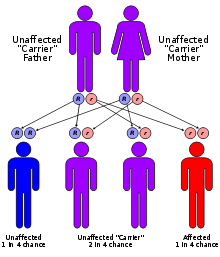- Walker–Warburg syndrome
-
Walker–Warburg syndrome Classification and external resources OMIM 236670 DiseasesDB 29495 Walker–Warburg syndrome (WWS), also called Warburg syndrome, Chemke syndrome, HARD syndrome (Hydrocephalus, Agyria and Retinal Dysplasia), Pagon syndrome, cerebroocular dysgenesis (COD) or cerebroocular dysplasia-muscular dystrophy syndrome (COD-MD),[1] is a rare form of autosomal recessive congenital muscular dystrophy.[2] It is associated with brain (lissencephaly, hydrocephalus, cerebellar malformations) and eye abnormalities. This condition has a worldwide distribution. The overall incidence is unknown but a survey in North-eastern Italy has reported an incidence rate of 1.2 per 100,000 live births. It is the most severe form of congenital muscular dystrophy with most children dying before the age of three years.
Contents
Characteristics
The clinical manifestations present at birth are generalized hypotonia, muscle weakness, developmental delay with mental retardation and occasional seizures. The congenital muscular dystrophy is characterized by hypoglycosylation of α-dystroglycan.
Cause and Genetics
Several genes have been implicated in the etiology of Walker–Warburg syndrome,[3] and others are as yet unknown. Several mutations were found in the protein O-Mannosyltransferase POMT1 and POMT2 genes, and one mutation was found in each of the fukutin and fukutin-related protein genes.
Diagnosis
Laboratory investigations usually show elevated creatine kinase, myopathic/dystrophic muscle pathology and altered α-dystroglycan. Antenatal diagnosis is possible in families with known mutations. Prenatal ultrasound may be helpful for diagnosis in families where the molecular defect is unknown.
Prognosis
No specific treatment is available. Management is only supportive and preventive.
Eponym
WWS is named for Arthur Earl Walker and Mette Warburg.[4][5][6] Its alternative names include Chemke’s syndrome and Pagon’s syndrome; named after Juan M. Chemke and Roberta A. Pagon.[7]
References
- ^ Online 'Mendelian Inheritance in Man' (OMIM) 236670
- ^ Vajsar J, Schachter H (2006). "Walker–Warburg syndrome". Orphanet J Rare Dis 1: 29. doi:10.1186/1750-1172-1-29. PMC 1553431. PMID 16887026. http://www.ojrd.com/content/1//29.
- ^ Beltrán-Valero de Bernabé D, Currier S, Steinbrecher A, et al. (November 2002). "Mutations in the O-mannosyltransferase gene POMT1 give rise to the severe neuronal migration disorder Walker–Warburg syndrome". Am. J. Hum. Genet. 71 (5): 1033–43. doi:10.1086/342975. PMC 419999. PMID 12369018. http://linkinghub.elsevier.com/retrieve/pii/S0002-9297(07)60398-X.
- ^ synd/1202 at Who Named It?
- ^ Walker AE (1942). "Lissencephaly". Archives of Neurology and Psychiatry (Chicago) 48: 13–29.
- ^ Warburg M (March 1971). "The heterogeneity of microphthalmia in the mentally retarded". Birth Defects Orig. Artic. Ser. 7 (3): 136–54. PMID 4950916.
- ^ http://www.whonamedit.com/synd.cfm/1202.html
External links
- HARD syndrome; Walker–Warburg syndrome; Chemke syndrome; COD (cerebroocular dysgenesis) at NIH's Office of Rare Diseases
Diseases of myoneural junction and muscle / neuromuscular disease (G70–G73, 358–359) Neuromuscular-
junction diseaseMyopathy/
congenital myopathyADAROther structuralOtherOtherCategories:- Autosomal recessive disorders
- Muscular dystrophy
- Congenital disorders
- Rare diseases
- Syndromes
- Enzyme defects
- Genetic disorder stubs
Wikimedia Foundation. 2010.

